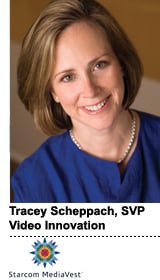 Cord-cutting forecasts present a cautionary tale for linear TV’s $70 billion ad market.
Cord-cutting forecasts present a cautionary tale for linear TV’s $70 billion ad market.
Interpublic Group’s media research and buying division, MAGNA Global, for instance, found live, DVR and video on-demand viewing decreased 14% year over year among the 18-24 demo set for the 2014-2015 season.
Conversely, eMarketer expects the viewership for connected devices like set-top boxes and game consoles to increase, estimating 35.5% of the US population will use a connected TV this year, a percentage that could double by 2017.
These trends account for what The Wall Street Journal described as “anemic” television upfront sales, which indicates advertisers and agencies historically active in traditional TV are beginning to plan and buy around audience and devices.
“The industry is absolutely coming to grips with the notion that TV advertising in the future will not be sold only on a content and time basis, which it largely is today,” said Dave Morgan, founder and CEO of television ad-targeting company Simulmedia.
AdExchanger checked in with Morgan, Disney ABC TV Group and others presenting during AdExchanger’s upcoming Industry Preview “TV Everywhere” panel about the convergence of digital video and TV in 2014 and beyond.
Audience Addressable, But Ads Inserted?
 In 2014, TV buyers had improved targeting due to better household addressability.
In 2014, TV buyers had improved targeting due to better household addressability.
“Over the last 10 years, the set-top box has gone from essentially not reporting back anything to over 104 million set-top boxes reporting back, second by second,” said Tracey Scheppach, senior vice president of precision video and innovation at Starcom MediaVest Group, adding that’s about half of the households that watch television.
“It’s a lot more than Nielsen’s got and that changes just about everything and puts TV in a more accountable position,” she said.
However, set-top boxes in and of themselves do not enable dynamic ad insertion. Michael Bologna, president of GroupM’s advanced TV unit, Modi Media, predicted only one-third of US households (42 million) enable dynamic ad insertion (DAI) at the household level.
AdExchanger Daily
Get our editors’ roundup delivered to your inbox every weekday.
Daily Roundup
“Viewing will continue to shift to on-demand platforms, a trend that will drive more rapid evolution in dynamic ad insertion and measurement solutions,” predicted Pooja Midha, senior VP of digital ad sales and operations at Disney ABC TV Group. “Improved measurement and the expansion of DAI will enable linear TV networks to provide marketers with even more powerful offerings.”
TV Everywhere Really Everywhere?
 Everyone talked about TV Everywhere in 2014, but NBCUniversal put a team, strategy and marketing campaign into action around the concept.
Everyone talked about TV Everywhere in 2014, but NBCUniversal put a team, strategy and marketing campaign into action around the concept.
“We’re trying to drive that concept across all 14 of our brands in a way that piques consumers’ interest and activates that online or in mobile,” said Alison Moore, GM and EVP of TV Everywhere for NBCUniversal.
The reasoning behind NBCUniversal’s push to “stream” its linear portfolio to both desktop and mobile through authentication was simple: These channels represent audience development opportunities for legacy broadcast businesses.
“All of our products and services are now held to a different bar,” Moore acknowledged. “Consumers are engaging with content via TV Everywhere, Netflix, Hulu, etc., and their expectations about the experience are quite high so we are thinking about how do we, as a brand, build new experiences for web, mobile and emerging platforms.”
A trend to watch in 2015 will be “Authentication Everywhere.” In order for a media brand such as NBCUniversal to deliver ads and content cross-platform, there must be a way to seamlessly manage viewer profiles.
 NBCUniversal says it is attacking that issue and working through the challenges around driving consistent experiences across devices and access for different types of content. One major cable provider, for instance, said only 26% of its subscribers were aware it offers online streaming capabilities and even fewer recalled its apps.
NBCUniversal says it is attacking that issue and working through the challenges around driving consistent experiences across devices and access for different types of content. One major cable provider, for instance, said only 26% of its subscribers were aware it offers online streaming capabilities and even fewer recalled its apps.
“We’re working with the MVPDs (multichannel video programming distributors) to figure out what paths we can build to make this seamless and as easy as possible,” Moore said. In NBC’s case, this means working with brands to figure out user-friendly authentication strategies and the iOS experience.
The Year Of The Private Marketplace
Programmatic came to the upfront in 2014 – at least as a private marketplace.
NBCUniversal rolled out private exchange offering NBCUx, ABC experimented with private marketplaces for video and ESPN got its feet wet when it announced a pilot test to run select SportsCenter inventory through a web-based auction.
NBCUniversal’s and ABC’s programmatic experimentation was primarily relegated to digital video and display inventory (with mobile soon to come) while ESPN flirted with automated TV ad spots.
“There’s no question we will see growth in private marketplaces for linear TV inventory operated by TV companies themselves or by third parties,” said Simulmedia’s Morgan. “And I call them marketplaces rather than exchanges because they’re more likely to be run like a Sotheby’s than like an eBay.”
In other words, TV inventory auctions will be highly curated.
 “[Broadcasters] will make things available in a marketplace where it’s more portfolio-enabled, data-driven and audience-based, and they’ll use marketplace tools where they feel they can yield more for their inventory,” Morgan said.
“[Broadcasters] will make things available in a marketplace where it’s more portfolio-enabled, data-driven and audience-based, and they’ll use marketplace tools where they feel they can yield more for their inventory,” Morgan said.
Early Programmatic Headway
On the surface, it looked like 2014 was the year digital video met linear TV in a programmatic setting. TubeMogul struck multiple TV supply-side deals and AOL combined TV ad targeting and digital to drive incremental reach.
While many of these companies have laid programmatic bricks, the word “programmatic” in TV is more about automated data application than real-time buying right now.
There’s virtually no linear TV inventory directly accessible (yet) through digital DSPs barring smaller-scale local buys, select primetime spots or, of course, digital video inventory from some of the networks.
“There will definitely be more automation and opportunity to take digital-like thinking about audience and optimization and apply that to TV,” Scheppach said. “The amount of data that’s coming to market is starting to open up, so agencies and (digital DSPs) of the world are trying to tell that data-optimization story, which is the right approach, but the reality is nothing’s connected.”
When these connections are made in the coming years, marketers will be able to buy across online video, video on demand and TV and “transact how it makes the most sense for them,” both on a commercial TV ratings and impressions basis, said ABC’s Midha.













